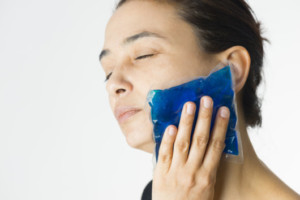The Maxillofacial Institute’s team of medical professionals answers the most common questions that people may have before having orthognathic surgery.
In facial malformations, the teeth in the maxillary and mandibular arch are usually misaligned. In these cases, the role of the orthodontist is essential, in order to align the teeth and prepare them for surgery.
The result of the combination of treatments, orthodontics and orthognathic surgery, is to recover the balance between all facial features, therefore a good diagnosis and a well-planned orthodontic treatment is key to successful orthognathic surgery.
The orthodontist must be in constant communication with the maxillofacial surgeon, and once the teeth reach the ideal position for surgery, both will decide when the patient is ready to go through the operating room. Normally, after surgery there is a period of adjustment in which the orthodontic treatment is continued, to finish placing the teeth and adjusting them in their new position, although in some cases this is not necessary.
These are the different orthognathic surgery protocols:
Protocolo Clásico
Classic Approach: It is followed in the vast majority of surgeries, and consists of orthodontic treatment, followed by orthognathic surgery, and then more orthodontic treatment.
Protocolo Surgery First
Surgery First: In this case, there is no prior orthodontic treatment before orthognathic surgery. Indicated in patients whose teeth are well aligned and the only thing they should correct is the existing disharmony between the jaw and maxilla.
Protocolo Surgery Last
Surgery Last: Orthodontic treatment followed by orthognathic surgery without subsequent orthodontic treatment. It is applied in patients who have already achieved a good orthodontic occlusion, but who do not have facial harmony due to a bad placement of the facial bones.
Protocolo Surgery Only
Surgery Only: Orthognathic surgery only. It is applied when the patient has a good occlusion and only needs a readjustment of the bone structure, either to treat problems such as Sleep Apnea or to achieve greater facial harmony.
It is important to emphasize that the protocol to be applied will be defined by the maxillofacial surgeon and the orthodontist, the patient cannot choose between one and the other, since this is defined based on the position of the patient’s bones and teeth.
When it comes to bimaxillary orthognathic surgery, anesthesia is general with overnight hospital admission. The patient returns home approximately at noon the next day, after a follow-up visit with their specialist.
On the other hand, if the orthognathic surgery is monomaxillary of mandibular advancement, it is carried out, thanks to the protocols designed by Dr. Hernández Alfaro, under local anesthesia and sedation without hospital admission. In this case, patients go home two hours after surgery.
During surgery at the Maxillofacial Institute, there is always an anesthesiologist present who controls the patient at all times. An anesthesiologist is a professional who is exclusively dedicated to this process: from defining the amount and type of drug to be used in each patient according to their state of health and type of procedure, to monitor the patient during surgery and immediately after its completion.
The meticulous control of blood pressure by the anesthesia team of the Maxillofacial Institute reduces blood loss during orthognathic surgery. In addition, the anesthesiologists of the Maxillofacial Institute use BIS for all orthognathic surgery patients, a device that allows to monitor the waves related to the anesthetic depth during surgery, thus achieving an excellent adaptation between the surgical and anesthesia time. Thanks to these techniques applied during orthognathic surgery, it has never been necessary to perform a blood transfusion.
Both local anesthesia and the dreaded general anesthesia are currently very safe procedures, and can be applied without problem to most people, provided they properly inform the anesthesiologist of any health problems, and follow the guidelines indicated for the patients. days and hours before surgery.
Dr. Federico Hernández Alfaro and his team have created protocols that significantly shorten surgical time.
Thus, orthognathic monomaxillary surgery has an average duration of 40 minutes in Maxillofacial Institute. Patients return home two hours after the surgery.
The bimaxillary orthognathic surgery in Maxillofacial Institute is performed in an average of 90 minutes. The patients stay 1 night in hospital and return home the next day.
Short surgery: The reduction of surgical time in this type of procedure greatly improves the postoperative experience of the patient, since the surgical trauma is minimal and recovery is almost immediate.
This reduction in surgical time is only achieved with experience and excellent training by the medical team. At the Maxillofacial Institute has performed an average of 5 orthognathic surgeries per week since 1994.
Orthognathic surgery is usually not painful. Although it seems hard to believe, very few patients report pain after their orthognathic surgery.

After many years of experience and comments, we have noticed that most patients report less pain than expected, although they often complain of some discomfort, such as the feeling of anxiety caused by the swelling of the walls of the nose, which hinders the air intake; a slight pain when yawning, sneezing and coughing, spasms in the jaw, and drooling. But as a rule, patients do not experience much pain at all.
It is important to bear in mind that the minimally invasive procedures during the surgery, and the specific post-operative care (mask of hilotherapy, and lymphatic massages) that we use in the Maxillofacial Institute significantly reduce post-surgical trauma.
In addition, all of our patients receive medication to reduce swelling and relieve pain, which in most cases is easily controlled with medication and rest. As a rule, patients can return to normal life within two to three weeks after their orthognathic surgery.
Regardless of this, we must keep in mind that different patients have different pain thresholds, and there is no way to determine who has a high threshold and who has a low threshold.
Aspects such as digital planning and new surgical techniques and protocols have made maxillofacial surgery much less invasive than a few years ago, and therefore recovery is also much faster.
 At the Maxillofacial Institute we are pioneers in minimally invasive orthognathic surgery techniques, this is the set of techniques and procedures related to surgery, anesthesia and postoperative care that reduce pain, inflammation, blood loss and complications in the patient during and after the surgery.
At the Maxillofacial Institute we are pioneers in minimally invasive orthognathic surgery techniques, this is the set of techniques and procedures related to surgery, anesthesia and postoperative care that reduce pain, inflammation, blood loss and complications in the patient during and after the surgery.
Thus, as a rule, patients operated in our center can return to their normal life within two to three weeks after their bimaxillary orthognathic surgery.
In cases of monomaxillary orthognathic surgery, the postoperative period is much shorter and in a few days the patient can return to daily routine.
Regarding the diet, soft diet is usually maintained until approximately 15 days after surgery, at which point the hard foods begin to be introduced little by little.
Regarding the incorporation to work, medical leave usually takes between 10 and 15 days. Of course this period varies depending on the work performed by the patient.
 Immediately after your orthognathic surgery you will find that your energy level is much lower, and it will take a while to get back to normal. Even so, and although we do not feel like it, physical activity (short walks) is important during the first few days to reduce inflammation and speed up recovery.
Immediately after your orthognathic surgery you will find that your energy level is much lower, and it will take a while to get back to normal. Even so, and although we do not feel like it, physical activity (short walks) is important during the first few days to reduce inflammation and speed up recovery.
Exercises such as walking or running can be restarted after about a month. If you practice sports normally, you need to resume your routine slowly and gradually increase within your comfort level until you reach your normal level.
Activities such as the sauna or pool should be avoided for at least 2 months, as well as lifting weights. On the other hand, contact sports can be resumed approximately 4 months after surgery, while wrestling or boxing should be postponed for approximately 8 months after your surgery.
It is important to bear in mind that all these times are orientative, since each patient has different characteristics. That is why you should always ask your maxillofacial surgeon for advice on the appropriate time to return to sports regularly.
During the entire postoperative process, it is very important to maintain a good supply of proteins and vitamins to help achieve healthy energy levels, although the food will go through different stages:
In the first week after surgery, the patient has a liquid diet. During this period it can be difficult to open your mouth enough to use a spoon, but it should be used as soon as possible, and you can start with very small spoons, like those of babies. It is especially important not to use straws, as the suction gesture produces more inflammation, so you should make the effort to drink from a cup from the first moment.
For this stage, juices, creams, smoothies, broths and purees are recommended. You can also use some type of dietary supplement (high in protein) to increase your calorie intake.
Once the week has passed, soft diet, which will last approximately 4 to 8 weeks, will start. During this time, the patient should consume soft and easy-to-chew food, since their bones are in the process of consolidation in their new position.
For this stage pasta, rice, very tender meats (hamburger type), tender fish, well cooked vegetables, etc. are recommended.
From the beginning of the third month approximately, patients will gradually introduce slightly harder foods and increase the level of hardness little by little. A person can return to their normal eating habits around the fourth month after their orthognathic surgery.
The team of professionals of the Maxillofacial Institute will detail each patient’s specialized dietary plan and will give you a recipe book specifically designed for patients who underwent orthognathic surgery, to have a greater variety in their diet.
